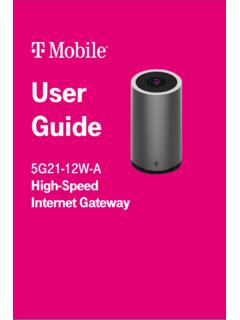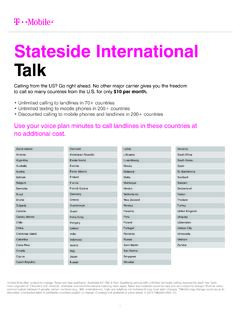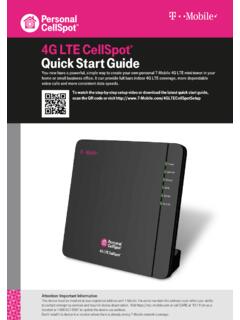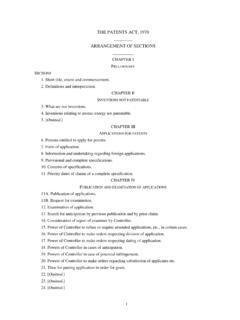Transcription of Enterprise Third-Party (Supplier) Information Security ...
1 Enterprise Third-Party (Supplier) Information Security Standard Approved by: Cyber Security & Privacy Policy Approver Page 1 of 12 Version: TISS-610:2018 | Contact: | Public 1 HERE S THE DEAL The purpose of this TISS-610 Enterprise Third-Party (Supplier) Information Security Standard ( Standard ) is to define T- mobile s Third-Party Information Security requirements that help meet T- mobile s overall risk management and Security objectives. Note This Standard is aligned to the Enterprise Third-Party (Supplier) Risk Management Program. T- mobile will complete an Enterprise (Supplier) Risk Management Program (ESRAP) intake for all Suppliers. The Cyber Assessment is triggered based off the results of the ESRAP intake. 2 WHAT S IN-SCOPE This Standard applies to all T- mobile Third-Parties (suppliers) and T- mobile personnel responsible for managing the supplier(s).
2 This standard defines the Security requirements that must be evaluated upon collaborating, changes in-scope-of-work and changes in the vendor Security environment. Third-Parties (Suppliers) includes, but not limited to, those performing any of the following: 1. Accessing, hosting, retaining, processing, or transmitting non-public T- mobile Information . 2. Developing, supporting, or managing technology, application(s), service(s), or solution(s) used for T- mobile business purposes whether residing within T- mobile s environment or hosted externally. 3. Any other work or partnership that, in T- mobile s view, triggers a need to review or compare a party s processes, procedures, and policies. 3 ROLES & RESPONSIBILITIES SUPPLIER Supplier is responsible for completing cyber assessment questionnaire and adhering the Security requirements in this Standard to implement appropriate technological, procedural, and physical requirements controls to protect T- mobile customers.
3 T- mobile S SUPPLIER CYBER RISK MANAGEMENT (SCRM) TEAM SCRM partners with T- mobile s Enterprise (Supplier) Risk Management Program (ESRAP) to ensure T- mobile meets certain compliance and regulatory obligations to protect T- mobile customers and Information , as defined in the Scope. As part of T- mobile s broader Digital Security Organization (DSO), SCRM performs detailed Cyber Assessments to ensure suppliers are compliant with the Standard. Enterprise Third-Party (Supplier) Information Security Standard Version: TISS-610:2018 | Contact: | Public Page 2 of 12 4 T- mobile Third-Party (SUPPLIER) Information Security REQUIREMENTS Information HANDLING REQUIREMENTS All T- mobile Information must be classified when created/received regardless of where it resides, the form it takes, or the technology used to handle it to enforce appropriate handling procedures as indicated in this Standard.
4 Information CLASSIFICATION T- mobile has defined an Information classification scheme to properly identify all T- mobile Information . The Information classification levels are used throughout this Standard. T- mobile will determine the classification of the Information you will be accessing, processing, and/or storing. Suppliers with multiple engagements at T- mobile , must adhere to the requirements of the highest classification level they will be accessing, processing, and/or storing. Information HANDLING FOR CUSTOMER FACING APPLICATIONS, SYSTEMS AND ACTIVITIES 1. Customer-facing applications, systems, and/or activities that utilize Customer Proprietary Network Information (CPNI) must meet CPNI compliance requirements as defined in T- mobile s CPNI requirements including practices for authentication of customers, notice of account changes, and unauthorized access incident tracking.
5 2. All systems/applications must be able to collect, track, and honor user preferences with respect to data collection including, but not limited to: a. Display a prominent notice and obtain affirmative consent of the user when collecting sensitive Information about them; b. Capability to obtain and track consent and include links to a detailed notice, or c. Provide the option of opting out of data collection. 3. CPNI Information must be stored within the boundaries of the United States. DISPOSAL OF Information ASSETS All non-public T- mobile Information must be returned to T- mobile or destroyed as defined in the contractual agreement. When Suppliers are performing media sanitation they must provide T- mobile a certificate of destruction upon request. Please reach out to for the form. When destruction is carried out by a disposal vendor, it is essential the Information is protected continuously from the time at which the Information asset is sent for destruction, until the time the disposal vendor has picked up the data.
6 Enterprise Third-Party (Supplier) Information Security Standard Version: TISS-610:2018 | Contact: | Public Page 3 of 12 The following destruction methods must be used where applicable (unless other methods are described in the contractual agreement): Information Assets Disposal Method Paper Cross-cut shredding, incinerating, or pulping such that there is reasonable assurance the materials cannot be reconstructed. mobile Computing Devices (cell phones, tablets, etc.) Delete all non-public T- mobile Information on the device(s). Electronic Storage Media (hard drives, USB/memory sticks, RAM, tapes, etc.) Physically destroy or sanitize media in accordance to NIST-800-88 Guidelines for Media Sanitization and verify removal of data. Optical Disks (CDs, DVDs, etc.) Use optical disk shredder or disintegrator. Disks can also be incinerated or grinders can be used.
7 INCIDENT REPORTING Supplier must have the capacity to immediately notify T- mobile of any Security breach and must assist T- mobile in investigating the Security breach in accordance with terms of an approved contract, work order, or master service agreement. Supplier must have technical, administrative and physical Security measures in-place so that vulnerabilities are disclosed responsibly, and that Information about a Security breach impacting T- mobile Information is not disclosed to the public until authorized to do so by T- mobile . ENCRYPTION REQUIREMENTS Encryption technologies must be used to protect T- mobile Confidential and/or Restricted Information . T- mobile Confidential and/or Restricted data must be encrypted at rest and in-transit (over public data networks and/or within the Supplier s internal network).
8 1. Information Transmission: SSHv2, or higher. 2. Encryption Standard: AES, RSA a. At Rest: i. Symmetric: AES 256 or higher ii. Asymmetric: RSAES-OAEP b. In-Transit: i. HTTPS, SSH, SFTP, Direct connection (dedicated circuit only for your scope of work with T- mobile ). 3. Usage of Proprietary Encryption Algorithm(s): must be reviewed, tested, and approved by T- mobile . 4. Hashing Algorithm/Password Storage: SHA 2, Bcrypt, Scrypt, Other (upon approval of T- mobile ) 5. Wireless Networks: WPA2 (WPA1 and WEP must not be used) 6. MD5 and less must not be used Enterprise Third-Party (Supplier) Information Security Standard Version: TISS-610:2018 | Contact: | Public Page 4 of 12 7. Unique T- mobile encryption keys should be used for encryption of T- mobile Confidential and/or Restricted Information , where possible.
9 8. Salts must be random per user and a minimum of 16 characters in length. 9. User credentials must be encrypted during the authentication process when transmitted using a secure communications channel. 10. Passwords/authentication data must be hashed at rest any time the password is stored. Passwords must not be stored or transmitted in clear text (human readable form). CRYPTOGRAPHIC REQUIREMENTS Supplier must have clearly defined and documented processes for managing cryptographic keys. 1. Keys must be physically protected. 2. Keys must never be stored in locations that do not meet secure key management requirements. 3. Keys must be changed annually. Old keys must be retired or destroyed. 4. For high Security keys, dual control or MFA must be implemented. 5. Key access must be restricted on a need to know basis.
10 6. Keys must be changed when employees with key access change job duties or leave the company. 7. Supplier using T- mobile DNS domains must get their SSL/TLS certificates from T- mobile . 8. All certificates used for T- mobile purposes must have minimum key lengths of at least 2048 bits (RSA). 9. Passwords used to protect cryptographic keys must be as strong as the keys they protect. ANTI-MALWARE 1. All systems supporting T- mobile ( , external/internal servers, mobile computing systems, firewalls, web application firewalls, routers, and end User equipment) must be installed with current anti-malware software appropriate for their operating system, if applicable anti-malware technology exists. 2. Quick response procedures must be formally documented to detail actions in the event of a malware attack. 3. All anti-malware software must be actively running, updated with current definitions, and capable of generating logs.













